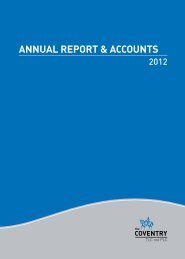Annual report and accounts 2009 (PDF) - Coventry Building Society
Annual report and accounts 2009 (PDF) - Coventry Building Society
Annual report and accounts 2009 (PDF) - Coventry Building Society
Create successful ePaper yourself
Turn your PDF publications into a flip-book with our unique Google optimized e-Paper software.
Loan impairment <strong>and</strong> other provisionsIAS 39 requires that loan losses are only recognised where there is objective evidence of impairment. The <strong>Society</strong> has appliedthis requirement in determining the level of losses present in its loans <strong>and</strong> advances to customers, but has been required toapply management judgement in determining the financial impact of this impairment. IAS 39 makes a distinction betweenindividual <strong>and</strong> collective impairment. Individual impairment relates to situations where individual assets are assessed for loss.The <strong>Society</strong> has used this approach on loans in possession <strong>and</strong> those in arrears. Estimates that have been applied includeassessing the likelihood of the loan going into possession for those cases currently in arrears, the length of time expected to berequired to complete the sale of properties in possession, <strong>and</strong> the expected costs of realisation. Collective impairment relates tocases where losses are assessed as being present in a loan portfolio, but they cannot be identified to individual <strong>accounts</strong>. Thisapproach has been used to calculate a value of incurred but not <strong>report</strong>ed losses, where statistical analysis has been used todetermine a value for losses where a loss event has already impacted an account, but has not yet manifested itself in arrearsdata. A portfolio approach is also used on sections of the loan book where there are known problems but individual <strong>accounts</strong> areagain as yet not identifiable. This method has been applied to loans advanced on city centre buy-to-let flats where a problem ofoversupply is having a negative effect on prices <strong>and</strong> ease of sale, with the result that the <strong>Society</strong> has made an impairmentprovision against these assets.The <strong>Society</strong> has also made provision for the expected cost of various customer claims. It is expected that the liability will mainlycrystallise over the next five years.Estimated asset livesThe <strong>Society</strong> recognises interest on loans <strong>and</strong> advances to customers on the basis of their effective interest rate. This is aconstant rate that averages out the effect of incentives <strong>and</strong> fees across the expected life of the loan account. A criticalassumption in the calculation is the expected life, as this determines the assumed period over which customers may be payingvarious differentiated interest rates. The calculation of the effective interest rate uses assumptions on expected life that arebased on the historic experience of similar products. These assumptions are monitored to ensure their ongoingappropriateness. Changes in the amortised cost balance arising from actual product life experience differing from the assumedlife, are periodically calculated <strong>and</strong> an adjustment made to the loan balance, with a corresponding adjustment to interest income.Also within the calculations, provision has been made for the uncertainty of the estimates in order to reduce the risk ofoverstatement of interest income.Valuation of derivatives <strong>and</strong> available-for-sale assetsThe fair values of derivative financial instruments <strong>and</strong> available-for-sale assets are based on open market prices, whereavailable. If open market prices are not available, the <strong>Society</strong> uses valuation techniques which comprise discounted cash flowvaluation models. The assumptions in these models are periodically reviewed to ensure that they remain relevant.FSCS levy provisionThe <strong>Society</strong> is committed to paying levy charges of the UK Financial Services Compensation Scheme (FSCS) (see note 14).All deposit-taking institutions who are members of the FSCS are required to contribute to the costs of the FSCS in safeguardingthe deposits of savers in failed financial institutions. The <strong>Society</strong> is, <strong>and</strong> continues to be, a member of the FSCS.Contributions to the FSCS are calculated according to a prescribed formula using the retail savings balances of all deposit-takinginstitutions that are members of the FSCS. The provision for these costs in this year’s <strong>accounts</strong> relates to payments to be madein future periods. The actual payments to be made are subject to change because they are based on estimations of therepayments by failed institutions <strong>and</strong> future interest rates.41
















